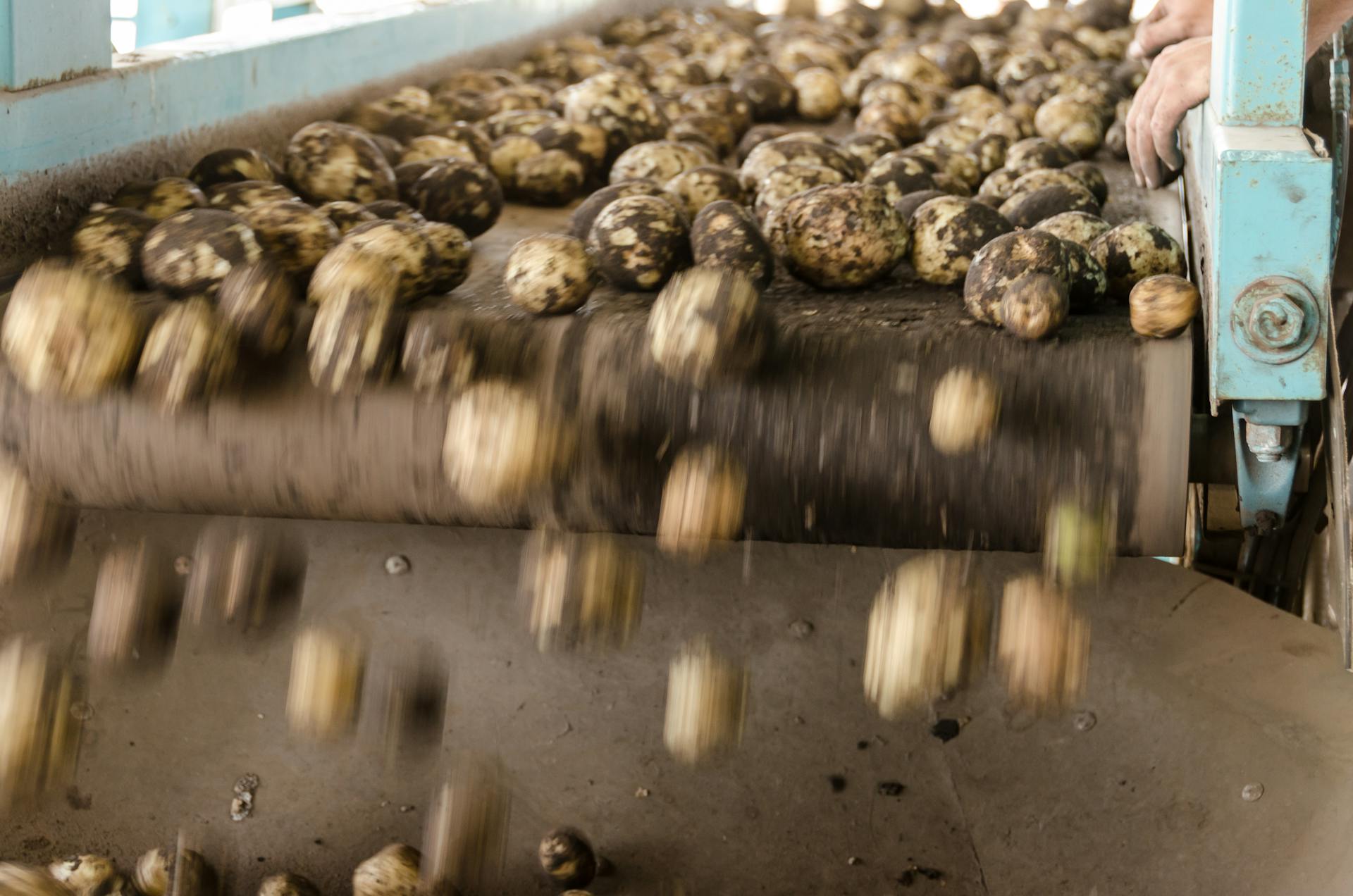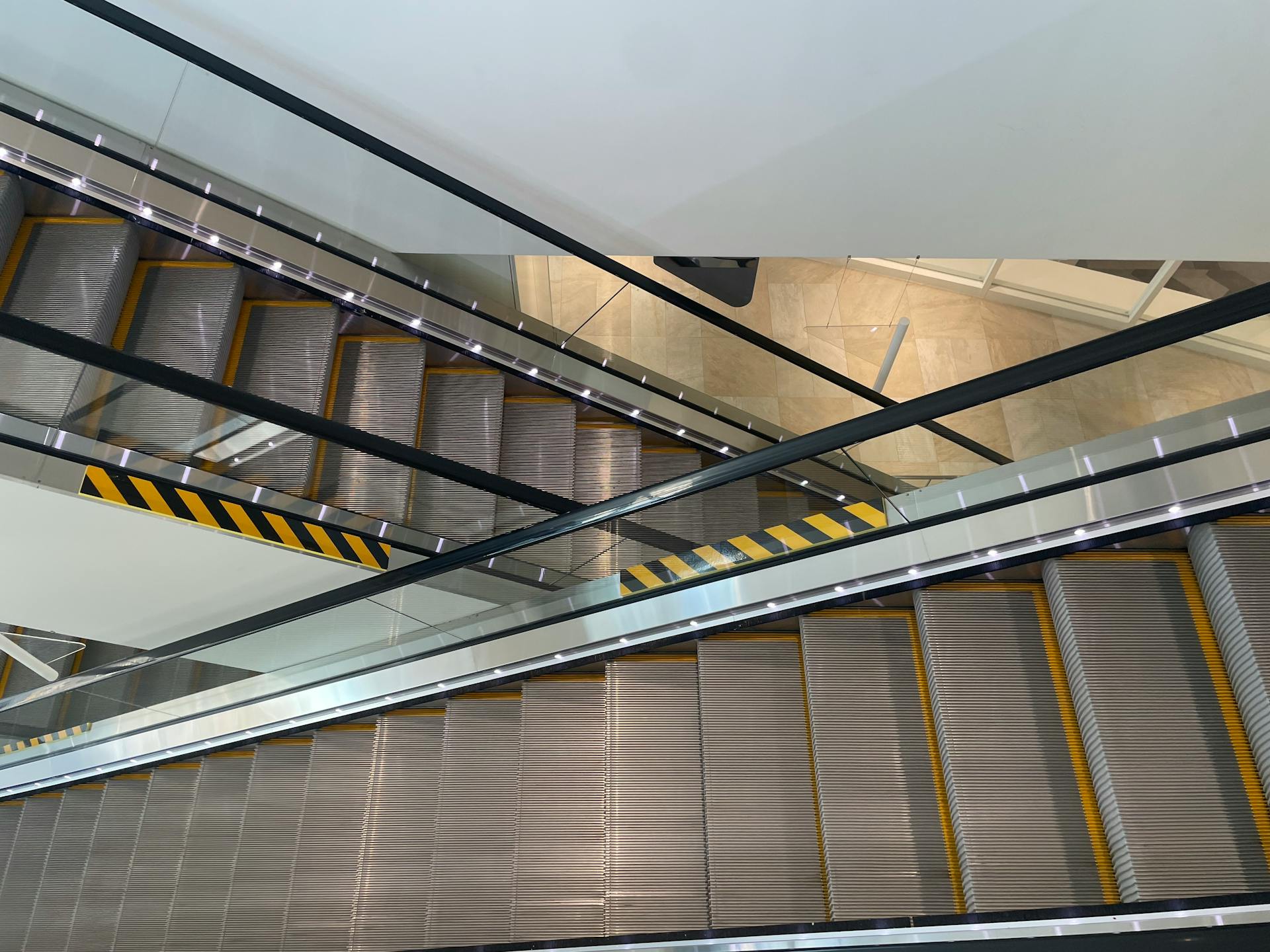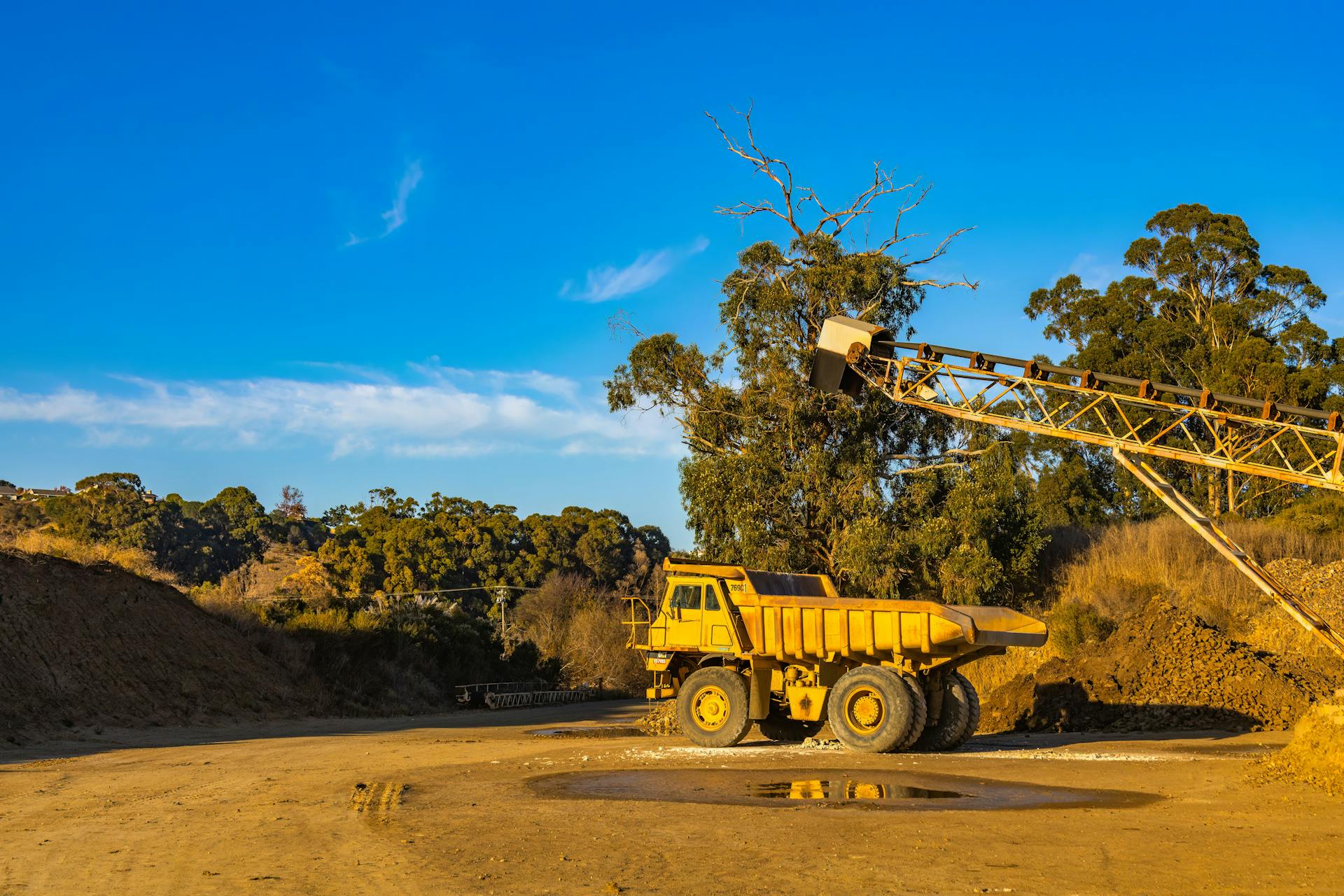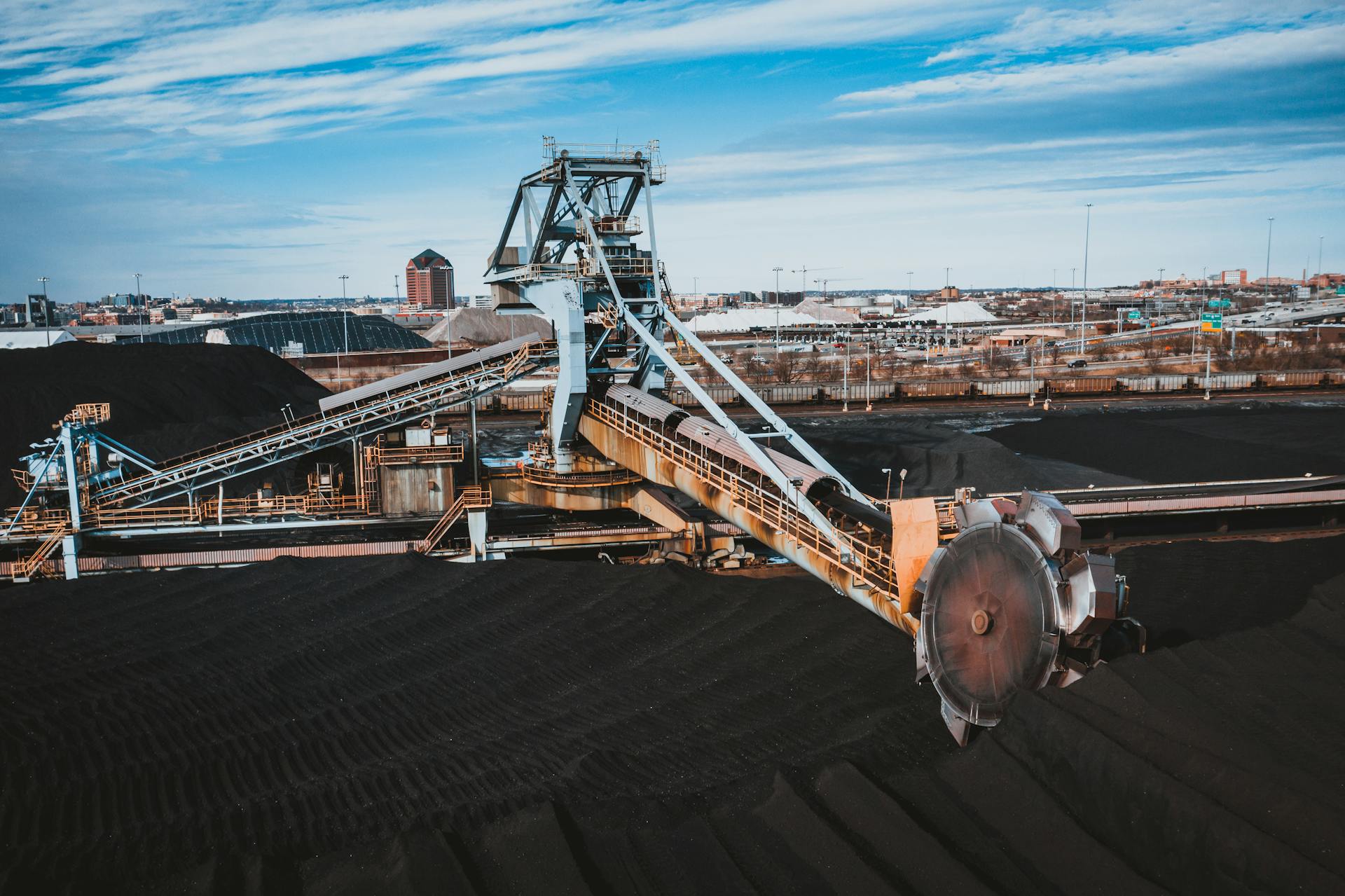
Machine conveyor systems are a staple in many industries, and it's essential to understand the different types, components, and applications they offer. There are several types of conveyor systems, including belt conveyors, roller conveyors, and chain conveyors.
Belt conveyors are a popular choice due to their flexibility and ability to handle a wide range of materials. They can be powered or gravity-fed, making them suitable for various applications.
Roller conveyors, on the other hand, are often used in manufacturing and packaging processes, where they can handle heavy loads and high speeds. Chain conveyors are commonly found in the food and pharmaceutical industries, where cleanliness and sanitation are paramount.
For your interest: Power and Free Conveyor Systems
What is a Conveyor System?
A conveyor system is an apparatus designed to transport packages, products, supplies, parts, and equipment for varied purposes.
Conveyor systems are used in material handling and production, and their design and configuration depend on the characteristics of the materials being conveyed.
The weight, size, and ease of movement of materials determine the type of conveyor system needed.
Examples of conveyor systems include pneumatic, screw, belt, and roller types.
Conveyor systems generally operate automatically, but there are also manual designs employing chutes and rollers.
These manual designs are often seen in retail, material handling, and shipping sectors.
Design and Configuration
A conveyor system's design and configuration are crucial to its performance and efficiency. Each system is tailored to meet a specific application, making it impractical to cover all possible configurations.
Conveyor systems come in various shapes, designs, sizes, and forms, including vertical, angled, horizontal, curved, or equipped with pockets, slats, and z-frames. They can be integrated in numerous ways to boost efficiency and speed.
To optimize performance, sophisticated software and control systems can be used. Automated PLC and VFD controls precisely manage speed, acceleration, and deceleration, while sensor integration monitors material flow, jams, and conditions. By leveraging data analytics, organizations can optimize performance, predict maintenance needs, and improve efficiency.
Here are some key considerations for designing and configuring a conveyor system:
- Custom engineering and design services to tailor the system to your needs
- Modular construction for easy reconfiguration and expansion
- Specialized accessories and components (e.g., specialty belts, sensors, controls)
- Integrated automation and control systems for enhanced efficiency
Design and Configuration

When designing a conveyor system, it's essential to consider the type of conveyor that will best suit your needs. A powered rollgang is ideal for pallets and cartons, while gravity rollgangs are more efficient and use less energy.
The uninterrupted operation of a conveyor system relies on the quality and durability of every equipment component, seamless integration with warehouse systems, and consistent maintenance. This is why companies like KAPELOU choose to custom-manufacture their conveyor systems to fit specific processes.
To optimize floor space, overhead conveyors are a great option. They can be designed as an enclosed track conveyor or an open track conveyor, depending on the application. Enclosed track conveyors protect the track from wear and simplify the incorporation of bends and curves into the system.
For long, straight configurations, open track conveyors are a good choice. They're easy to install and use I-beams as the track. Chain overhead conveyors use a continuously powered chain that travels along a track, with pendants attached at regular intervals to hang parts or products.
There are many types of conveyor systems, each with its own advantages and disadvantages. Here are some of the most common types:
- Automated conveyor systems use motors, sensors, and control systems to move materials without human intervention.
- Manual conveyor systems require physical human effort to operate, providing more flexibility for small-scale or variable operations.
- Low-profile belt conveyors are designed for applications with limited vertical space.
- Cleated conveyors use raised ridges or cleats to prevent items from sliding backwards on inclines.
- Beltless magnetic conveyors use powerful magnetic fields to move ferrous materials without a physical belt.
- Steel hinge belt conveyors use interconnected steel plates as the conveying surface.
- Wire mesh belt conveyors feature an open wire mesh belt, allowing for air circulation, drainage, or product cooling.
- Telescoping conveyors are extendable conveyors that can adjust in length to reach various distances.
- Oscillating/shaker conveyors use vibration or oscillating motion to move materials along a slightly inclined trough or platform.
- Roller conveyors consist of a series of parallel rollers for moving boxes, pallets, or other flat-bottomed items.
- Chain conveyors use one or more chains to pull or push items along the conveyor path.
- Overhead conveyors transport items overhead to save floor space.
- Vertical conveyors move materials between different floor levels in a vertical or near-vertical path.
- Servo Motor driven conveyors use precise indexing for applications like inspection stations or automation.
- Specialized conveyor types include pneumatic conveyors, vibrating conveyors, and more.
Configuration
Conveyor systems come in a wide variety of shapes, designs, sizes, and forms. They can be vertical, angled, horizontal, curved, or equipped with pockets, slats, and z-frames.
Each system is tailored to meet a specific application, making it impractical to cover all possible configurations. However, it is essential to understand that there are very few limitations on integrating a conveyor system, regardless of the application.
Conveyor systems can be configured to meet the specific needs of a facility. For example, low-profile belt conveyors are designed for applications with limited vertical space, while cleated conveyors feature raised ridges or cleats attached to the belt surface to prevent items from sliding backwards on inclines.
The type of conveyor system chosen will depend on the characteristics of the materials being conveyed, such as their weight, size, and ease of movement. Additionally, the operating environment, including temperature, humidity, dust, and chemical exposure, can impact the choice of materials and construction for the conveyor system.
Here are some common conveyor system configurations:
- Overhead conveyors: Suspended from above, these systems transport items overhead to save floor space.
- Vertical conveyors: They move materials between different floor levels in a vertical or near-vertical path.
- Telescoping conveyors: These conveyor systems are extendable conveyors that can adjust in length to reach various distances.
- Roller conveyors: They consist of a series of parallel rollers for moving boxes, pallets, or other flat-bottomed items.
- Chain conveyors: These conveyor systems use one or more chains to pull or push items along the conveyor path.
Each of these configurations has its own unique benefits and applications, and the right choice will depend on the specific needs of the facility.
Drive
The drive of a conveyor system is a crucial component that provides the power to move materials. It can be designed to move items in both directions and can be positioned at the system's middle, end, or beginning.
Most belt conveyors have their drive located at the discharge or head of the belt. This is a common practice, but other locations can be used depending on the design.
The drive can feature single or variable speeds, and variable speed drives have gained popularity in modern conveyor systems. This allows for adjustments to material flow.
AC motors are generally used to power the pulley that moves the belt. They are a reliable and efficient choice for conveyor systems.
The motor is coupled to the conveyor through a drive mechanism, such as a gearbox or chain drive. This is the "heart" that propels the conveyor system.
In some cases, pneumatic and hydraulic drives are used instead of electric motors. These options can be suitable for specific applications, such as conveying liquids, granular materials, or powders.
Take a look at this: Shore to Ship Power Systems
Monorail
Monorail systems are a great choice for transporting materials over long distances. They effectively utilize overhead space in the production area.
The carriers in monorail systems can lower to the production level and then rise out of the way when not in use. This makes them ideal for spaces with limited floor area.
Monorail conveyors receive power through signal lines from conductor lines embedded within the mounted rails. This allows for efficient power transmission.
Monorail systems can be designed to optimize space usage. They can include vertical, spiral, and inclined transporter lines to make the most of available space.
In terms of power efficiency, monorail systems can help reduce energy costs. They are designed to be energy-efficient and dependable, which can lead to lower operating costs.
Monorail systems can also improve working conditions by reducing physical strain on staff. By automating goods handling processes, employees can focus on other tasks and reduce their workload.
Components and Maintenance
Conveyor systems consist of a series of components, including a belt or chain, rollers and pulleys, motor and drive, controls and sensors, and a support structure.
The lifespan of a conveyor system can vary significantly depending on the type, with belt conveyors lasting 10-15 years with proper maintenance, chain conveyors lasting 8-12 years, roller conveyors lasting 15-20 years, and pneumatic conveyors lasting 8-12 years.
Regular inspections are crucial for maintaining the longevity of conveyor systems, and should include checks for wear, damage, misalignment, and proper lubrication.
Here are some key strategies for implementing a comprehensive preventive maintenance program:
- Regular inspections: Check for wear, damage, misalignment, and proper lubrication.
- Scheduled maintenance: Follow the manufacturer's recommendations for cleaning, lubricating, and replacing worn parts.
- Condition monitoring: Use sensors and data analytics to predict maintenance needs.
- Proactive repairs: Address minor issues before they escalate into major problems.
- Operator training: Educate users on proper conveyor operation and care.
What Is a Conveyor Belt?
A conveyor belt is essentially a continuous loop of material that forms the backbone of a conveyor system. Typically made of rubber, plastic, fabric, or metal, it's what physically transports materials from one point to another.
The type of material used for the belt depends on the specific application, with rubber and plastic being common choices for general-purpose use. Fabric and metal belts are often used in more specialized situations.
As the pulleys rotate, the belt moves, carrying items placed on top of it. This is how conveyor belts are able to efficiently move materials along a conveyor system.
Conveyor belts are designed to handle a wide range of materials, from small packages to heavy or irregularly shaped objects. Chains are often used in applications requiring more positive traction, like moving heavy or irregularly shaped objects.
In some cases, the belt can be made of a combination of materials, such as a rubber core with a fabric or metal reinforcement. This can provide added strength and durability to the belt.
Load Capacity
Load capacity is a crucial aspect of conveyor system design. It's essential to determine the maximum weight a conveyor can carry to avoid damage or operational interruptions.
The load capacity of a conveyor system depends on several factors, including its overall length, bed width, and drive system. For example, a conveyor with an 8" bed width and a 6' overall length can carry a maximum weight of 220 pounds with a 4-inch diameter drive pulley.
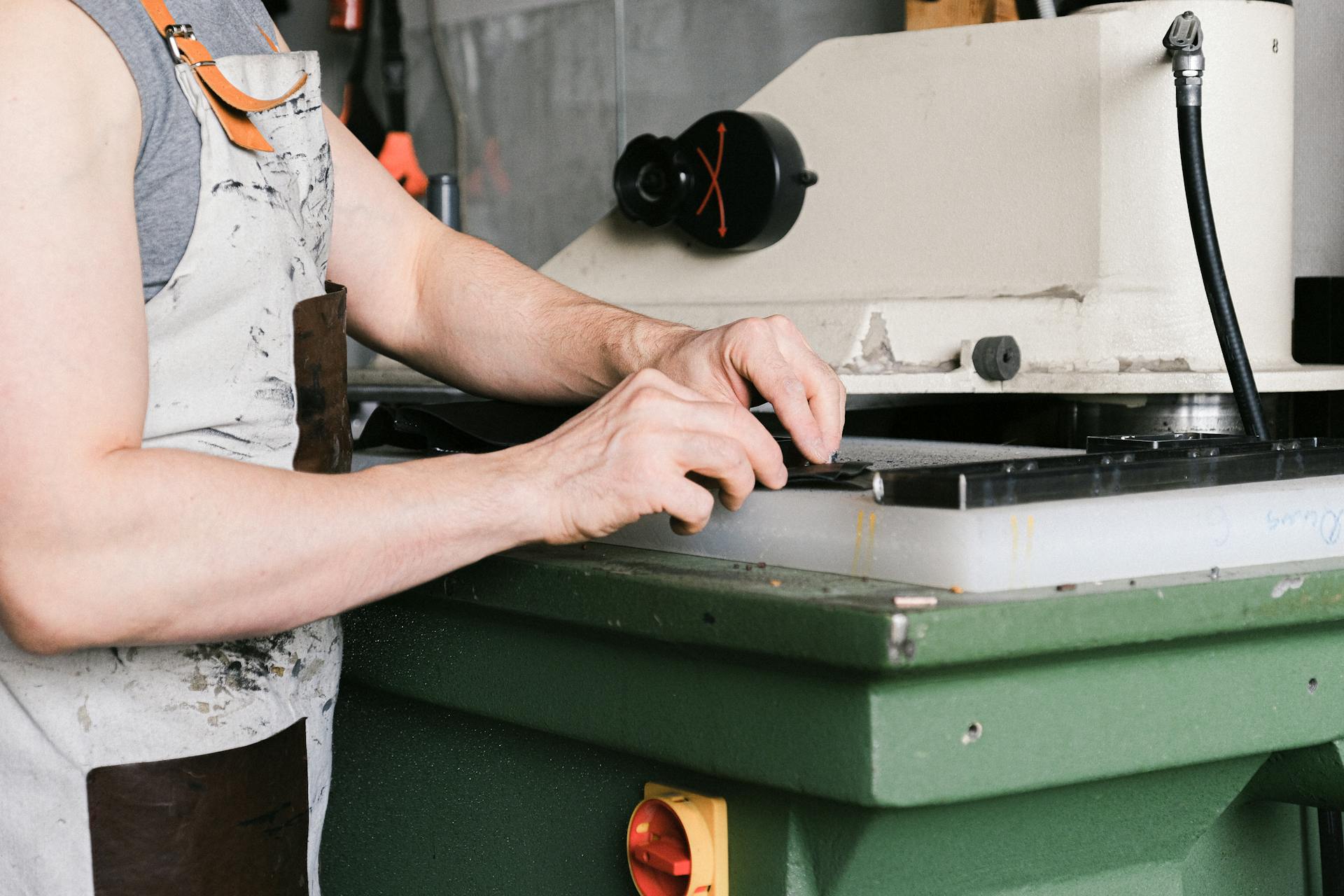
Conveyor systems with larger bed widths and overall lengths can carry significantly more weight. A conveyor with a 16' overall length, a 16" bed width, and an 8-inch diameter drive pulley can carry up to 300 pounds.
Here's a breakdown of the maximum weights for various conveyor configurations:
Keep in mind that these values are based on the specific configurations listed and may vary depending on the actual system design and components used. It's essential to consult the manufacturer's specifications and consult with an expert if you're unsure about the load capacity of your conveyor system.
Types of
Types of conveyor systems are crucial for efficient material handling.
There are various types of conveyor systems, including automated and manual systems. Automated conveyor systems use motors, sensors, and control systems to move materials without human intervention, offering increased efficiency and consistency. Manual systems, in contrast, require physical human effort to operate, providing more flexibility for small-scale or variable operations.
Some conveyor systems are designed for specific applications, such as low-profile belt conveyors, which are ideal for applications with limited vertical space. Cleated conveyors are also available, featuring raised ridges or cleats attached to the belt surface to prevent items from sliding backwards on inclines.
Here are some common types of conveyor systems:
- Automated vs. manual systems
- Low-profile belt conveyors
- Cleated conveyors
- Beltless magnetic conveyors
- Steel hinge belt conveyors
- Wire mesh belt conveyors
- Telescoping conveyors
- Oscillating/shaker conveyors
- Roller conveyors
- Chain conveyors
- Overhead conveyors
- Vertical conveyors
- Servo Motor driven conveyors
- Specialized conveyor types
In addition to these, there are also radial stackers, overland conveyors, transfer conveyors, railcar loading and unloading conveyors, barge loading and unloading conveyors, and pit conveyors. Each of these types of conveyor systems is designed for specific applications and industries.
Belt
Belt conveyors operate using motorized pulleys with a thick, durable belt looped around them. When the motor is activated, the belt is pulled between the pulleys.
A belt cleaner is necessary to remove any carryback that remains on the belt after the load has been discharged. Carryback is a common issue in all belt systems and is a major cause of belt malfunctions.
Belt tracking is critical to prevent premature wear on belt conveyors. Issues with belt tracking may arise from misuse, environmental factors, or inadequate maintenance.
Belts are typically made of rubber, plastic, fabric, or metal and form a continuous loop around pulleys. As the pulleys rotate, the belt moves, carrying items placed on top of it.
Chains are used in applications requiring more positive traction, such as moving heavy or irregularly shaped objects. The belt or chain is the "muscle" that physically transports materials from one point to another.
There are several types of carryback, with the most common being when material adheres to the belt and continues past the transfer point before falling off.
Chain
Chain conveyors can feature one or multiple sets of chains that come into contact with the bottom of the items being transported.
Chain-driven conveyors are well-suited for items with uneven bottom surfaces or those that are very heavy, and can support pallets placed directly on their robust frames.
Chain conveyors typically operate at a slower pace due to the nature of the items they handle.
A chain on edge conveyor is a single-strand chain conveyor that operates on its side, utilizing a roller chain that moves within a plate-supported channel.
Chain on edge conveyors are more versatile than traditional chain-driven conveyors due to their ability to make various twists and turns.
Chain conveyors can be equipped with motors positioned along the conveyor frame to power evenly spaced rollers, similar to motorized roller conveyors.
Pulley Bearings
Pulley bearings are fully lubricated to protect against water and contaminants.
Regular maintenance is key to extending the life of pulley bearings. Manufacturers recommend scheduling maintenance based on the frequency of system use.
Pulley bearings typically do not require repairs when regularly inspected and maintained.
It's essential to keep pulley bearings lubricated to prevent damage from water and contaminants.
Cleaning
Cleaning is crucial for the longevity and efficiency of your system. Regular cleaning of belts, rollers, chains, motors, slats, and all accessible areas is essential.
Contamination from substances like treatments or coatings can lead to damage to components, making it particularly important for systems handling products with these substances.
I've seen firsthand how a buildup of debris can slow down a system, so it's essential to clean regularly to maintain optimal performance.
ANSI B11 Standards
ANSI B11 Standards provide a framework for ensuring the safe operation of conveyors, outlining requirements for their construction, installation, maintenance, inspection, and operation.
ASME B20.1-2018 is a specific standard that outlines requirements for the construction, installation, maintenance, inspection, and operation of conveying systems.
These standards are essential for maintaining the integrity and safety of conveyors, which is critical for preventing accidents and ensuring compliance with regulations.
ANSI B11.19 provides additional details on safety procedures for permanent, temporary, and portable conveyors, highlighting the importance of tailored safety protocols for different types of conveyors.
ANSI B11.0 is another standard that complements ASME B20.1 and ANSI B11.19, providing a comprehensive framework for understanding the safety requirements of conveyors.
By following these standards, organizations can ensure that their conveyors are designed, installed, and operated in a way that prioritizes safety and minimizes risks.
For another approach, see: Transportation Management System Requirements
Automated Unloading
Automated Unloading can be a game-changer for many industries, as it eliminates the need for manual labor and can significantly reduce labor costs.
Conveyors can be designed to automatically unload materials, eliminating the need for manual labor.
This can be especially beneficial for companies with high volume production or those that handle heavy or bulky materials.
Longevity and Maintenance
The lifespan of a conveyor system can vary significantly depending on the type, with belt conveyors lasting 10-15 years, chain conveyors 8-12 years, roller conveyors 15-20 years, and pneumatic conveyors 8-12 years.
Proper maintenance is key to extending the lifespan of your conveyor system. Regular inspections, scheduled maintenance, and condition monitoring can help predict maintenance needs.
Belt tracking is a common issue that can lead to premature wear on belt conveyors. It's essential to check belt tracking each time the belt is activated to prevent costly repairs.
Regular cleaning is crucial for all conveyor systems, regardless of type. This includes cleaning belts, rollers, chains, motors, slats, and all accessible areas.
Pulley bearings are designed to be fully lubricated to protect against water and contaminants. Regular inspections and maintenance can help prevent the need for repairs.
Here's a summary of the expected lifespan of different conveyor system types:
Proper maintenance and operating conditions are essential to extending the lifespan of your conveyor system.
Sustainable Solutions

Sustainable Solutions are becoming increasingly important in the manufacturing industry. Many conveyor system manufacturers are now developing eco-friendly solutions to meet this need.
Energy-efficient motors are being used in conveyor systems to reduce energy consumption. This is a significant step towards sustainability.
Regenerative braking systems are also being integrated into conveyor systems to minimize energy waste. By doing so, businesses can reduce their carbon footprint.
Conveyor systems are now being designed to generate their own power through kinetic energy recovery systems. This innovative approach reduces reliance on external energy sources.
Industry-Specific Applications
Machine conveyor systems are used in various industries to improve efficiency and productivity. They can be customized to meet specific needs, such as heavy-duty systems for manufacturing and sanitary equipment for food processing.
Conveyor systems have transformed material handling in industries like manufacturing, warehousing, and mining. They enable the smooth flow of materials, components, and finished products through assembly lines and efficiently move raw materials while withstanding harsh conditions.
Here are some industry-specific applications of machine conveyor systems:
- Manufacturing: Customized conveyor systems for handling different product sizes, weights, and shapes.
- Warehousing: Automated conveyor systems for fast, reliable transport of goods, including boxes, pallets, and small items.
- Mining: Conveyors that efficiently move raw materials while withstanding harsh conditions and can operate at speeds of up to 100 feet per minute.
- Automotive: Overhead, floor-mounted, and pallet conveyor systems for efficiently transporting and assembling vehicle components.
What Are Applications
Conveyor systems are used in various industries to enhance production speed and efficiency. They have become a crucial component in material processing and movement.
Automated conveyor systems are critical for boosting warehouse productivity across sectors like e-commerce, retail, pharmaceuticals, automotive, and manufacturing. These systems can be used to automate specific areas or serve as the backbone of a fully integrated warehouse system.
Conveyor lines can be used to connect different warehouse zones or move goods across multiple levels. They deliver high-speed transport, precision handling, and reduced reliance on manual labor.
Some of the key industries that use conveyor systems include e-commerce, retail, pharmaceuticals, automotive, and manufacturing. These industries rely on conveyor systems to boost warehouse productivity and efficiency.
Conveyor systems can handle a wide variety of goods, including boxes, trays, and cartons, pallets, small items in soft packaging, bags, or envelopes. They are designed and manufactured to meet the specific needs of each industry.
For more insights, see: Warehouse and Transportation Management System
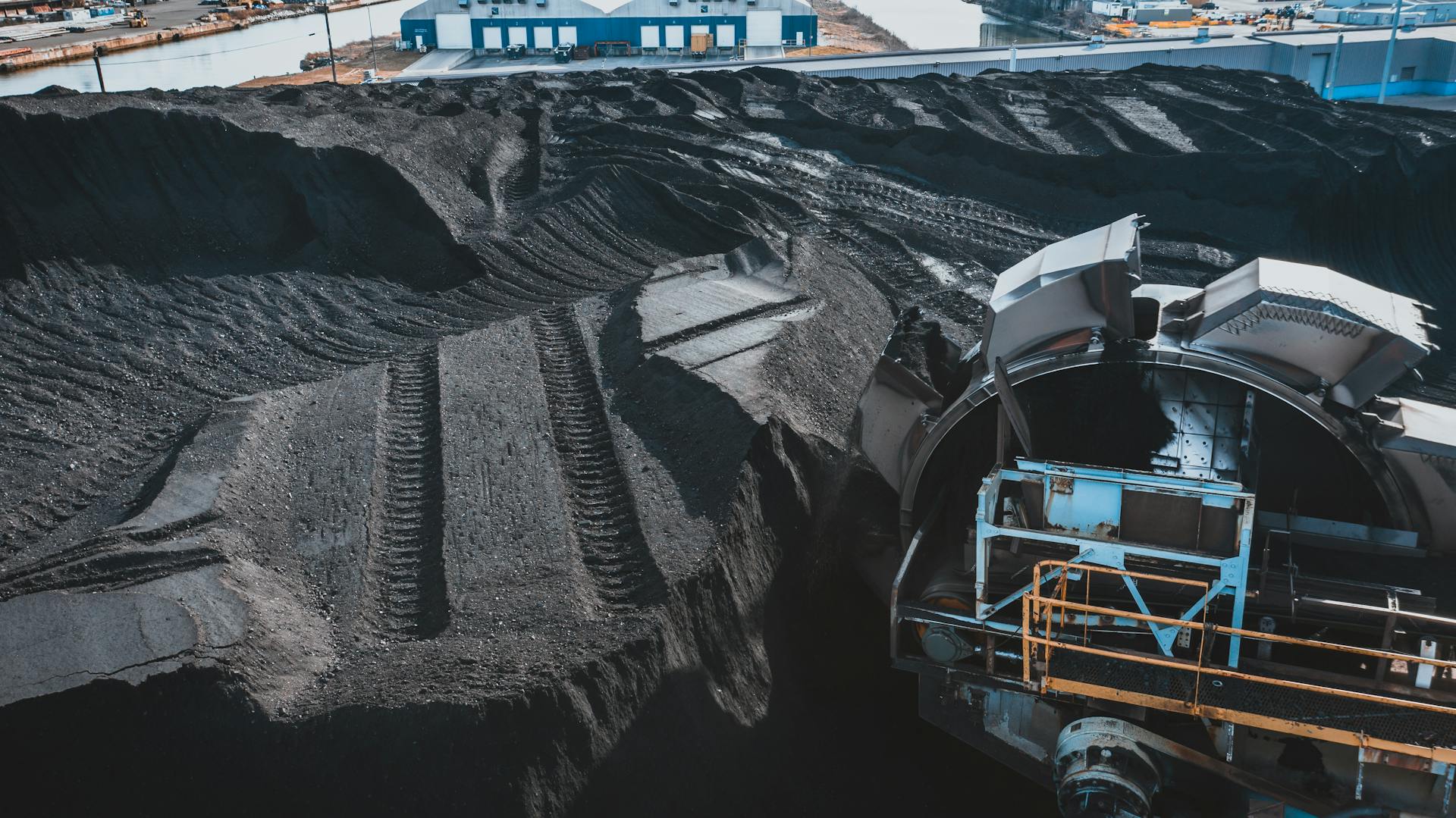
Here are some of the key standards and specifications for conveyor systems:
- ANSI/ASME B20.1 - Safety Standard for Conveyors and Related Equipment
- ANSI MH16.1 - Specification for the Design, Testing, and Utilization of Industrial Steel Storage Racks
- ANSI MH10.8 - Material Handling Equipment and Systems
Conveyor systems can be designed and manufactured to meet the specific needs of each industry, including speed and direction of movement. They are also scalable to support future expansion.
Manufacturing and Warehousing
Manufacturing and warehousing are two sectors where conveyor systems play a crucial role in improving efficiency and productivity.
Conveyor systems in manufacturing enable the smooth flow of materials, components, and finished products through assembly lines (Example 5). They can be customized to handle different product sizes, weights, and shapes.
In warehouses, conveyor systems are essential for maximizing performance (Example 3). Automated conveyor systems for boxes and pallets can be used to automate specific areas or serve as the backbone of a fully integrated warehouse system.
Conveyor systems in warehouses can handle a wide variety of goods, including boxes, trays, and cartons, pallets, small items in soft packaging, bags, or envelopes (Example 3). They are designed and manufactured using high-quality, certified materials to ensure long-term reliability and performance.
Some key standards and specifications for conveyor systems in manufacturing and warehousing include ANSI/ASME B20.1 - Safety Standard for Conveyors and Related Equipment, ANSI MH16.1 - Specification for the Design, Testing, and Utilization of Industrial Steel Storage Racks, and ANSI MH10.8 - Material Handling Equipment and Systems (Example 4).
Here are some key features of conveyor systems in manufacturing and warehousing:
- High-speed transport
- Precision handling
- Reduced reliance on manual labor
- Modular design for easy installation and integration
- Scalability to support future expansion
- Reverse transport enabled via electric drives with variable rotation
Benefits and ROI
A machine conveyor system can bring numerous benefits to your production process. It can enhance efficiency and productivity, running continuously 24/7 to significantly boost throughput compared to manual handling.
Conveyor systems can move massive volumes of material per hour, outpacing manual methods. This automation creates a more coordinated production flow, reducing bottlenecks and idle time. Breaking down tasks into specialized steps along a conveyor line can also lead to increased expertise and faster completion.
The cost reduction and labor savings are substantial. Conveyor systems dramatically cut direct labor costs by minimizing manual material handling needs. While initial material and installation costs may be high, conveyors provide a cost-effective long-term solution compared to expanding workforce or facilities.
Conveyor systems minimize the need for workers to lift, carry, or manipulate heavy or awkward loads, significantly reducing injury risks. Well-designed conveyors promote better working postures and reduce physical strain.
The benefits of a conveyor system are numerous, including:
- Increased efficiency and productivity
- Cost reduction and labor savings
- Improved safety and ergonomics
- Enhanced material flow and inventory management
- Scalability and flexibility
- Quality control and consistency
- Space optimization
- Environmental benefits
A conveyor system can generate long-term savings through reduced labor, increased productivity, improved quality, and decreased accident-related costs. Calculating ROI involves estimating total savings versus total costs over the system's useful life.
Troubleshooting and Maintenance
To keep your machine conveyor system running smoothly, regular inspections are a must. This means checking for wear, damage, misalignment, and proper lubrication on a regular basis.
Implementing a comprehensive preventive maintenance program is key to maximizing the longevity of your conveyor system. This includes scheduled maintenance, where you follow the manufacturer's recommendations for cleaning, lubricating, and replacing worn parts.
Some common issues that can impact conveyor longevity include belt wear, chain wear, roller or bearing failures, motor and drive issues, electrical and control system malfunctions, and buildup of debris or material on the conveyor. Prompt troubleshooting and addressing these problems through maintenance or repairs is crucial to prevent further deterioration.
To stay on top of maintenance, consider using condition monitoring through sensors and data analytics to predict maintenance needs. This can help you catch potential problems before they become major issues.
Asme Guidelines
ASME guidelines are crucial for ensuring the safe use of machinery, including conveyors. ASME B11.0-2020 outlines safety standards for conveyors, specifying various safety devices to be included in the installation and construction process.
These standards are designed to prevent accidents and ensure the safe operation of conveyors. ASME B20.1-2018 provides guidelines for the design, construction, maintenance, and operation of conveying systems, with a focus on safety and hazard prevention.
ASME B20.1-2018 is specifically intended for industrial conveyors and does not apply to those designed for transporting people. It's essential to follow these guidelines to prevent accidents and ensure the safe operation of conveyors.
The ASME B20.1 standard covers requirements for the construction, installation, maintenance, inspection, and operation of conveying systems. ASME B20.1 and ANSI B11.19 are often used together to ensure compliance with safety guidelines.
By following these guidelines, you can help prevent accidents and ensure the safe operation of your conveyor system.
Continuous Operation
Continuous Operation is a key benefit of certain systems, allowing materials to be continuously loaded and unloaded over extended periods without interruption or stoppage.
This means that production or processing can keep going without any downtime, which is a huge advantage for businesses that rely on a steady flow of materials.
Materials can be continuously loaded and unloaded over extended periods without interruption or stoppage, making it easier to manage inventory and meet demand.
This continuous operation also reduces the risk of equipment failure, as the system is designed to run for extended periods without needing to be stopped.
Troubleshooting and Maintenance
Troubleshooting and maintenance are crucial for the longevity of your conveyor system. Proper maintenance can extend the lifespan of your conveyor system by up to 15 years, depending on the type.
Regular checks for belt wear, chain wear, and roller or bearing failures can prevent major repairs. These issues can be avoided by scheduling regular maintenance checks.
A buildup of debris or material on the conveyor can also cause problems. Keeping the work area clean and free of debris can help prevent tripping hazards and ensure the conveyor system operates smoothly.
Operators must be trained on proper start-up, shutdown, and emergency response procedures. They should also be educated on hazard identification, risk assessment, and the use of personal protective equipment (PPE).
Here are some common issues that can impact conveyor longevity:
- Belt wear, damage, or tracking problems
- Chain wear, elongation, or misalignment
- Roller or bearing failures
- Motor and drive issues
- Electrical and control system malfunctions
- Buildup of debris or material on the conveyor
Immediate reporting of unusual noises, vibrations, or malfunctions is essential. Proper lockout/tagout procedures must be followed during maintenance to prevent accidents.
A seized roller can cause mistracking issues, which can lead to uneven wear or damage to items on the belt. Maintaining clean, debris-free work areas and ensuring all guards, safety devices, and emergency stops are functioning properly is necessary.
Proper maintenance and operating conditions can extend the lifespan of your conveyor system. The expected lifespan of a conveyor system can vary significantly depending on the type, with belt conveyors lasting up to 15 years and pneumatic conveyors lasting 8-12 years.
Slippage
Slippage is a common issue on belt conveyors. It can happen if the tension is either too high or too low, leading to belt stretching and subsequent slippage.
High tension on a belt conveyor can cause the belt to wear down faster, leading to slippage. This is because the belt is under too much stress, causing it to stretch and lose its grip.
Low tension, on the other hand, can also cause slippage. If the tension is too low, the belt may not be able to move efficiently, leading to slippage and potential damage to the conveyor system.
Regular maintenance can help prevent slippage on belt conveyors. This includes checking and adjusting the tension regularly to ensure it's within the recommended range.
Operational Safety and Best Practices
Operational safety and best practices are crucial when working with machine conveyor systems. Safety is perhaps the most important consideration organizations should prioritize when selecting, installing, and configuring conveyor systems.
Comprehensive operator training is essential for the safe use of conveyor systems. Training should cover an overview of the system components and how they function, as well as proper start-up, shutdown, and emergency response procedures.
Operators must be educated on hazard identification, risk assessment, and the use of personal protective equipment (PPE). Lockout/tagout protocols for maintenance and reporting procedures for incidents or malfunctions should also be emphasized.
To ensure safe operation, operators must never walk, stand, sit or ride on a conveyor unless it is specifically designed for that purpose. Keeping hands, feet and loose clothing away from moving parts is crucial.
Here are some key safety elements to look out for in conveyor systems:
By following these best practices and ensuring compliance with regulatory standards, organizations can create a secure work environment for employees and prevent accidents. Regular inspection and upkeep of these safety systems is essential to ensure their continued effectiveness.
Future Trends and Integration
The future of machine conveyor systems is looking bright, and it's all about integration and innovation. One of the key trends emerging is the integration of cutting-edge technologies like IoT and AI to make conveyor systems smarter, more efficient, and more adaptable.
These advancements will enable real-time data sharing and analytics, allowing for more informed decision-making. Machine learning algorithms can analyze historical data to predict demand and optimize routing.
The integration of robotics with conveyor systems is also creating new possibilities for automation. Robotic arms can be used to load, unload, and sort items on conveyor belts.
Artificial Intelligence (AI) and machine learning are being increasingly integrated into conveyor systems to enhance decision-making and adaptability. This synergy between conveyors and robotics is enabling more flexible and adaptable material handling solutions.
As conveyor systems continue to evolve, we can expect to see a growing emphasis on sustainability and robotics. This means more efficient use of resources and reduced waste.
Machine learning algorithms can also be used to automatically adjust conveyor speeds and settings, further optimizing efficiency.
If this caught your attention, see: Semi-automatic Stretch Wrap Machine with Scale
Choosing a Provider
Industry experience is crucial, so look for a provider with extensive experience in your specific industry and application.
A provider with a proven track record in your industry and application is essential for understanding the unique challenges and requirements you face.
A wide range of conveyor types and accessories is necessary to meet your current and future needs, so ensure the provider offers a comprehensive range of products.
Custom-engineered solutions tailored to your facility layout and product characteristics are key, so assess the provider's ability to provide custom-engineered solutions.
Reliability and quality are critical, so choose a provider known for delivering high-quality, durable equipment that minimizes downtime and maintenance requirements.
Here are some key considerations to evaluate when choosing a conveyor system provider:
A provider's after-sales support and service are just as important as their initial sales pitch, so ensure they offer comprehensive training for your staff on the operation and maintenance of the conveyor system.
Frequently Asked Questions
What are the OSHA regulations for conveyor systems?
According to OSHA regulations, only authorized personnel can operate, repair, or service conveyor systems, and all safety devices must be in place and functioning properly
What is the most common conveyor system?
The most common conveyor system is the Gravity Conveyor, which uses rollers or wheels to convey product down a line using gravity. This simple yet effective system is widely used in various industries due to its reliability and low maintenance requirements.
Sources
Featured Images: pexels.com
